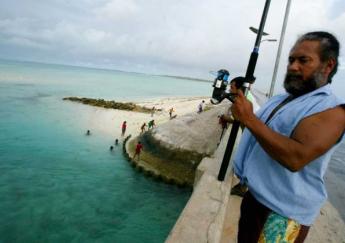In what seems a unique strategy for coping with its colonial history, death and burial practices on the tiny island nation of Kiribati, a string of atolls in the Indian ocean comprising one of the smallest countries in the world, incorporate diverse elements of the hugely influential Christian missions, as well as local pagan religions that date far back into the island’s ancestry.
In what seems highly reminiscent of 19th Century traditional Christian burial, the body is laid out in their home for a period of days so that loved ones can pay their respects. This can last up to three days, or longer if the recently passed was a prominent member of the community. A wake is conducted, complete with eulogies, coin and food offerings and the gathering of kinsfolk, and the body is buried either in a local cemetery or near to the family’s home. Many could be forgiven for detecting more than a hint of what we in the U.S. now call a “home funeral,” but which was merely a typical funeral from and before the early part of this Century.
But then the local customs kick in. Several months later the body is exhumed, and the skull removed. Mourners oil and polish the skull, present it with offerings of food and tobacco, and place it on a shelf in the home. The remainder of the body is re-interred. This practice, known as skull burial, was in stark opposition to the teachings of the Protestant and Catholic missionaries of the 19th Century, who were against the exhuming of corpses — it was believed that the presence of the skull in the home facilitates the native god Nakaa to welcome the spirit of the dead into the afterlife. Grieving widows or family members would sometimes carry the skull around as well. Today almost 95% of Kiribatians are practicing Catholics or Protestants, and yet the old traditions live on as well in testament to the durability of local death customs, which have proven themselves again and again to be among the most fiercely guarded and carefully administered practices the world over.
- Learn more about home funerals in our Before Death and After Death informative content sections.

 Traces of Several Religions in the Kiribati Ritual of Skull Burial
Traces of Several Religions in the Kiribati Ritual of Skull Burial



 “As Tears Go By” by Marianne Faithfull
“As Tears Go By” by Marianne Faithfull
 “The Sea” by John Banville
“The Sea” by John Banville
 Funeral Favors Offer Visitors a Tangible Memento
Funeral Favors Offer Visitors a Tangible Memento















